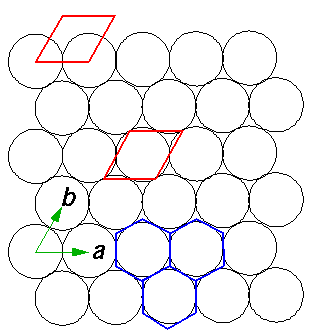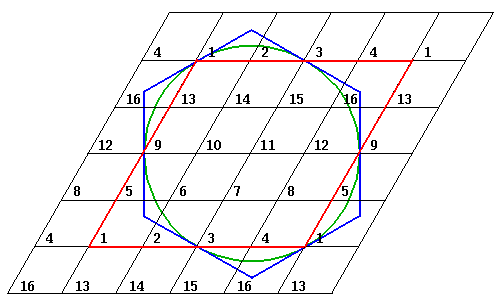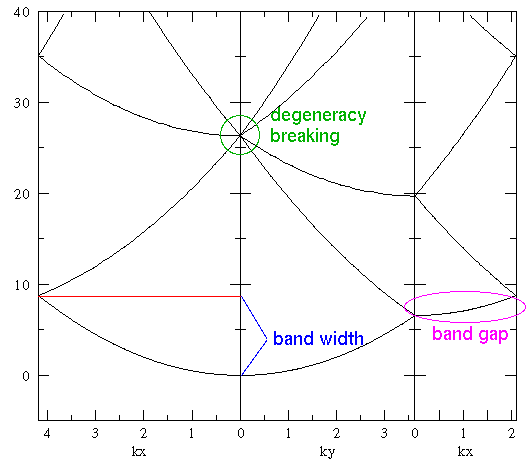- We have used particular a and b
vectors to generate our lattice:

Find another set of vectors which would work just as well.
What does this do to the reciprocal lattice space?
- Consider a particle with E=5 in lattices
with depths V0=16,64,256. Set up a computer
program to integrate the classical equations of motion. Determine
how long it takes on average for the particle's velocity vector
to be redirected by 90° from its original direction by the
periodic potential. The above "average" is over possible initial
conditions.
- Consider both the rhombus and hexagon tiles:

Show how the pieces of the hexagon outside of the rhombus
can be used to fill in the parts of the rhombus not filled by
the hexagon.
- Pick out two of the rows for each of the matrices
and demonstrate that the matrices work as required.
(The matrices are on page 4.)
- Using the Taylor expansion of an arbitrary function, show that
the approximation for the Laplacian works.
- Click here to get a
pdf file with the tour of the Brillouin zone of the free lattice.
Print it out.
Click here to get a
pdf file with the reciprocal lattice with labeled points.
Print it out. For every
band in free lattice, find its degeneracy and label it as to
its source (use the labeling of the reciprocal lattice vectors
in the second printout).
- Consider the "band gap" area of the free lattice band
structure.

in the context of the exact solution to to the grided lattice:

The second term (and higher order terms) are the source of
(computational artifact) band gap. Evaluate this second order
for all hexagon vertex points and all hexagon side-midpoint
points for h=1/8. Compare to the presented results.
Does this term follow the symmetry of the lattice?
- We have found an exact solution (free lattice) to a problem
similar to our problem of interest (lattice with potential).
We should then be able to treat the deviation between the
exactly solvable case and the case of interest as a perturbation
(i.e., use V as a perturbation to a free lattice).
What is the result of using first order perturbation theory
in this way?
- I claimed the V0=128 corresponds to having
the first excited state of the extended potential at E=0.
Prove this result.
- On page 8 I displayed a variety
of free lattice wavefunctions which lacked uniform probability
densities because of degeneracy. Pick out one of the two fold degenerate
cases. Find and plot the linear combination that diagonalizes
V.
- For the case k=(max,0) the (free lattice)
ground state is three-fold
degenerate. What are the three degenerate states? Find the
linear combination that diagonalizes the potential. (Note that
no matrix elements need to be calculated: the form of the V
matrix determines the eigenvectors). Compare the eigenfunctions
to those plotted on page 8.
- Duplicate the work of these pages, except this time for a 2D
square lattice.



